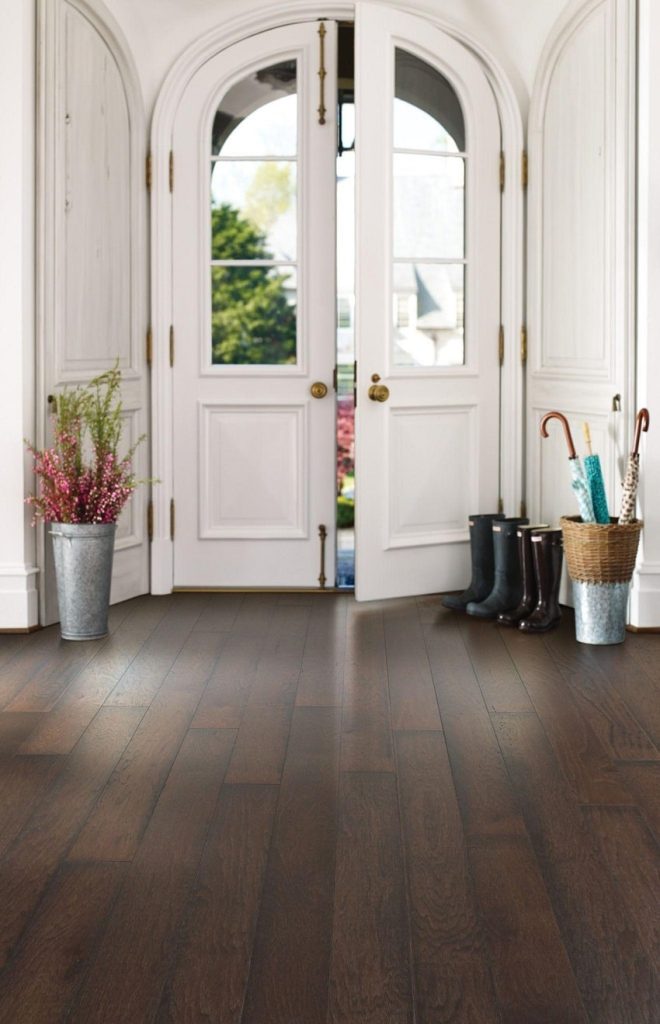Flooring can instantly transform a room. Considering how wall colors will affect the look is an essential consideration in the design of your space. The number of paint colors is nearly endless, and it can seem overwhelming to pick the right one. To help you make the decision easier, here is a guide on choosing colors that go with your flooring.
Light flooring tones

Determining a paint color for use with light flooring is simple; keep it light. If you choose a flooring tone to brighten up your space, pick light paint colors to match. The pairing of light flooring and walls creates a clean look and a feeling of a larger area. Utilizing the light-on-light tactic is used in various design styles, such as Scandinavian, Transitional, and Modern. These focus on elegant and sleek designs centered around light neutral spaces acting as a clean backdrop.
White is the easy choice; it is not only great for ash or white oak flooring but makes the coordinating of decor easy. White comes in several different variations, have fun determining the perfect shade of white for your space. If white is too plain for your style, try some close but not so bright colors. When choosing what color walls to pair with light flooring, cream and off-white colors can have a similar effect while adding yellow undertones for some warmth and color.
Neutral colors such as grey, beige, taupe, or greige are a great way to match light flooring choices while characterizing your walls. Avoiding darker variations of yellows and browns is advised as these will clash.
–Grey: The neutral’s neutral. The blend of black and white is a straightforward tone that works well with everything. Grey can also bring hints of warm or cool tones, adding subtle color.
–Beige: A lighter beige creates a naturally warm color that will direct the attention to your room decor instead of distracting from it. The warmth makes warm woods and metal feel like they belong while also helping cooler accent pieces pop.
–Taupe: Taupe is a mixture of dark grey and brown. Taupe can be used as the foundation of interior design. It can serve as a very stylish backdrop for decor and furniture. Taupe also works well in different levels of light.
–Greige: Greige is a popular color and is also a mix of grey and beige. Taupe and greige have the same base colors; taupe tends to be warmer beige while greige is more grey. Greige is typically considered a cooler color than taupe. Greige will give your room an understated hint of colors that serves as a strong foundation for the rest of your design.
Grey Flooring Tones

Grey flooring is a popular choice for many homeowners and will continue to be widely used. When choosing a paint color to go with grey flooring, it is essential not to go all grey. This can cause a depressing and monochromatic feeling. When matching colors with grey flooring, it is highly recommended to go with blue tones.
Blue is cool and relaxing, and it complements grey flooring well. To keep the contrast to a minimum, you should stick with cool tones. You do not want to select a blue with too many green shades, such as aqua or turquoise. Ice and navy blues tend to pair better with grey flooring tones. Blue-greys can be explored, but it is vital to ensure that they are predominantly blue, or they could dampen the mood of the design when paired with grey floors.
Much like light-colored flooring, white walls can pair easily with grey flooring. The grey and white combination will give a clean and open look. It is important to avoid yellowish undertones; however, such as cream, stick to pure whites and cool whites for the best results.
Although turquoise and aqua should be avoided because of their green undertones, a dusty green shade will often work well with grey flooring. Sage and pale greens with a grey touch create a dynamic, cool tone in your space. The grey takes away the warmth, while the green adds color to the room.
Dark Flooring Tones

Coordinating your walls with your floor’s undertones will create an alluring design with a smooth transition. Some colors that work well with warm undertones in your floors include cream, seashell, muted taupe, soft gold, amber, peach, blush, terra-cotta, brown, and beige.
On the contrary, if you’re looking for a contrast of color, use a cool wall color to pair with warm undertone flooring. Some colors may include blue, mermaid green, light purple, greige, cool silver, aqua, teal, seafoam, and periwinkle. These contrasts can give a room style without clashing.
Accent walls can create an outstanding balance. Utilizing an accent wall is a great way to explore the design of a room without going over the edge. Having the walls all one color is a more definitive design statement. Including a pop of color can create a big statement without breaking the design rules.
Matching your floors and walls does not have to be a complicated endeavor. Remember to consider undertones and avoid clashing colors. Try to balance aesthetic elements that can become overwhelming. If you follow this guide, you should have no problem choosing a paint color and floor that you will love.




